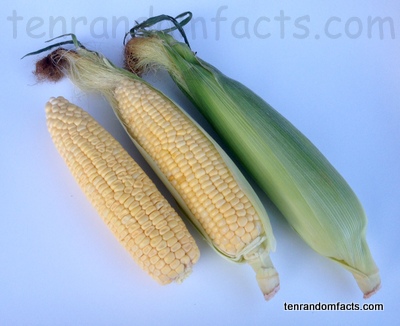You cannot get jokes more sweet corn-y.
- Sweet corn is a maize variety that has a particularly sweet taste in comparison to other varieties of maize, and it is also known as ‘pole corn’ and ‘sugar corn’.
- The scientific name of the sweet corn plant is Zea mays saccharata or Zea mays rugosa, and it is from the family Poaceae, the family of true grasses.
- Sweet corn has a higher quantity of sugar and less starch than other maize varieties, and it is believed that this is caused by a natural mutation, and the cobs are harvested before they are mature, to ensure maximum sweetness.
- A single sweet corn plant produces a range of one to three cobs each, that typically range from 20 to 25 centimetres (8 to 10 inches) in length.
- Generally sweet corn hardens and becomes starchy easily, meaning it should be eaten soon after picking and stored only for short periods of time in a cool location.
- Sweet corn can be steamed, microwaved, baked, boiled and barbecued, and is readily available in supermarkets and can be bought fresh, frozen or canned, and sometimes ‘creamed’.
- Even though sweet corn is technically a grain, it is often eaten as a vegetable, commonly with peas, as a side to a main meal; with beans in Central and South America; and once the kernels are removed from the cob they are commonly used in salads and main meal dishes.
- Sweet corn kernels are typically a yellow or white colour and they have a sweet flavour, and while on the cob, they are typically surrounded with a green leafy husk and strands of hair, known as ‘silk’.
- Native American tribes were the original growers of sweet corn, and it grew in popularity around the late 1700s, when it became accessible to Europeans.
- Sweet corn is very high in fibre, folate, thiamin, magnesium, phosphorus, vitamin C, and contains many other vitamins and minerals.
Bibliography:
Corn, 2013, Fresh For Kids, http://www.freshforkids.com.au/veg_pages/corn/corn.html
How To Grow: Sweet Corn, 2013, SBS, http://www.sbs.com.au/food/article/2012/09/06/how-grow-sweet-corn
Sweet Corn, 2015, Victoria State Government Agriculture, http://agriculture.vic.gov.au/agriculture/horticulture/vegetables/vegetables-a-z/sweet-corn
Sweet Corn, 2015, Wikipedia, https://en.wikipedia.org/wiki/Sweet_corn







